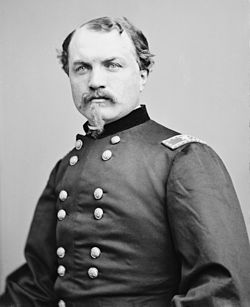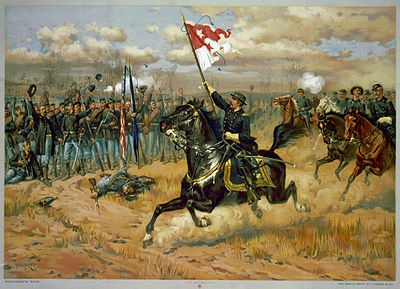As the day dawned over the bloody field of Chickamauga on, Sunday, September 20th, William Rosecrans, commander of the Union army, was riding along his lines, encouraging the troops. They had been sorely tested the day before with several Confederate attacks nearly breaking their line, but Rosecrans urged them to fight on, saying, “Fight today as well as you did yesterday, and we shall whip them!”
Across the field, Confederate commander Braxton Bragg had planned to attack at daylight, but the orders he had sent to D. H. Hill had been lost. When morning came Hill was unprepared, still getting his troops into position. They would attack on their right, where the Federal right had formed into a semicircle around the Kelly House. The Yankees had spent their night profitably, building breastworks to better defend themselves. Finally, at about 9:45 am, the Confederate attack began.

On the Confederate far right was Breckinridge's division. It was in such a position that his two rightmost brigades extended beyond the left of George Thomas's breastworks. Thomas, seeing that he was flanked, requested reinforcements. He withdrew two brigades from his line and threw them in front of Breckinridge. They fought hard, and although they were driven back, they bought enough time for Van Cleve to bring his division up from the right. Thomas was able to hold back the Confederate attack with these troops, but he did not feel his line was secure. As the battle raged, he requested Rosecrans to send him more troops from the center and right. Breckinridge and Cleburne continued to press forward, meeting heavy resistance. Liddell's and Gist's men were brought up and the attack was renewed, but fresh Union troops were moved to that portion of the line and no progress could be made. Stewart's division gained some success, but they were driven back by a Federal counter attack. Nathan Bedford Forrest's cavalry were dismounted and fighting on foot. When Hill saw them, he asked what infantry they were. When he was told they were Forrest's cavalry, he said:
General Forrest, I wish to congratulate you and those brave men moving across that field like veteran infantry upon their magnificent behavior. In Virginia I made myself extremely unpopular with the cavalry because I said I had not seen a dead man with spurs on. No one could speak disparagingly of such troops as yours.
By noon, the attacks slowed down. Polk and Bragg had failed to break Thomas's line, protected as it was by breastworks. As on the previous day, Bragg had not concentrated enough strength on one point to crush the line, and instead dispersed the blow. But Rosecrans had a problem. Because of the heavy pressure on the left, he had sent Thomas many reinforcements, leaving only four divisions on the right.
It was Longstreet's turn to attack. Because of all the troops rushed to Thomas, a hole had developed in the center of the Union line. Rosecrans had received false information about a gap in his line, and in giving orders to correct it, actually created a gap. Longstreet got permission from Bragg to attack with his wing. Instead of the piecemeal attacks used in the battle so far, throwing in only one a division at a time, Longstreet marshaled four divisions with which to crush the Federals. He ordered his men forward at 11:15 am. Confederate Bushrod Johnson wrote:
The scene now presented was unspeakably grand. The resolute and impetuous charge, the rush of our heavy columns sweeping out from the shadow and gloom of the forest into the open fields flooded with sunlight, the glitter of arms, the onward dash of artillery and mounted men, the retreat of the foe, the shouts of the hosts of our army, the dust, the smoke, the noise of fire-arms—of whistling balls and grape-shot and of bursting shell—made up a battle scene of unsurpassed grandeur.

Longstreet's men went right through the hole in the Federal line, past the Brotherton Farm, crushing any resistance they encountered. By noon he was a mile deep in the Federal center, having capturing 17 cannon and over 1000 prisoners along the way. Soon the entire left and center of the Yankee line was one race to get away from Longstreet's advancing men. But the Texas Brigade was struck with a counterattack from a Union unit, and driven into retreat. Hood, seeing his old brigade in full retreat, rode to rally them. He was shot through the leg, and carried off the field. Although such woods were frequently fatal during, he had his leg amputated and survived. This left him with only two limbs, as he had lost the use of his arm in another battle.
Having crushed through the Union center, Longstreet ordered his men to execute a right wheel and turn on Thomas. This complicated maneuver took time to preform, and during the lull he ordered that his men be fed to prepare them for further fighting. Bragg was annoyed that his battle plan had was unsuccessful, and that Longstreet had developed his own plan, and it was winning the day. So he rode off the field and left the management of the battle to his subordinates.
 |
| Rosecrans |
Bragg was not the only commander leaving the field. Rosecrans himself, joined by two of his corps commanders and thousands of men, was making off as fast as possible, believing further defense useless. Most officers completely lost their heads and tried to get away just like the common soldiers. But not all of the Federals were retreating. George Thomas remained on the field to organize the Union defense, and his firmness in stemming the Union rout would earn him the title the “Rock of Chickamauga.” He established a line of defense on Horseshoe Ridge, at right angles to the original position. Many Federals rallied there, still determined to resist the victorious southerners. They declared with resolution, “We will hold this ground or go to heaven from it.”

Through the afternoon waves of Confederates attacked Thomas's troops on Horseshoe Ridge. At 4:30 pm Longstreet's troops advanced. The fighting centered around Snodgrass Hill, upon which Longstreet made 25 attacks. The Federals were holding firm with hard fighting, but Thomas knew that this could not last forever. He was attacked on two sides by forces twice his number. He realized that at some point the position had to fold, and so he determined to conduct an orderly retreat. The gradual retreat began at 5:30 pm and continued over the next two hours. A rearguard of three regiments was left to defend the hill to the last. When they ran out of ammunition, they stood firm with bayonets. Refusing to abandon the position, they were finally surrounded and forced to surrender.
 |
| Horseshoe Ridge |
The Federals retreated during the evening, routed but not destroyed. Thomas, the Rock of Chickamauga had been able to put up a last ditch defense so that the Union army was saved from complete destruction. This good defense would have important implications in the campaign, and it prevented a Union army from being nearly wiped off the map.
 |
| Thomas |
The Confederates were elated at their victory, the first real victory won by Bragg's army. They let out cheers the like of which would be never heard again. They had captured 8000 prisoners, 51 cannon, over 23,000 rifles and much ammunition and other supplies. It was the largest quantity of supplies captured in one battle in the war. But it had been a costly battle. Rosecrans had lost 16,170 men, Bragg, 18,454. The total of almost 35,000 was a huge number. It was the second bloodiest battle of the war, only exceeded by Gettysburg. D. H. Hill wrote after the war,
There was no more splendid fighting in '61, when the flower of the Southern youth was in the field, than was displayed in those bloody days of September, '63. But it seems to me that the elan of the Southern soldier was never seen after Cickamauga .... He fought stoutly to the last, but, after Cickamauga, with the sullenness of despair and without the enthusiasm of hope.































